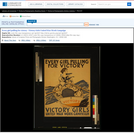
Poster showing a young woman rowing a boat, "Victory."
- Subject:
- History
- U.S. History
- Material Type:
- Diagram/Illustration
- Primary Source
- Provider:
- Library of Congress
- Provider Set:
- Library of Congress - World War I Posters
- Date Added:
- 06/18/2013

Poster showing a young woman rowing a boat, "Victory."
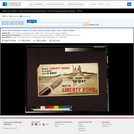
Poster showing a shell, marked Second Liberty Loan, being shot toward German submarine.
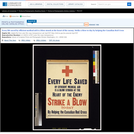
Title from item. Poster is text only. No. 6.

Since this lesson focuses on the swastika and other hate symbols—hate symbols that target a range of identity groups including Jewish people, people of color, etc.—it is important to be mindful that seeing and discussing these symbols could be upsetting for some or many of your students. Some students may feel relieved or comfortable discussing these issues in class and others may feel nervous, uncomfortable or angry to be talking about a topic so close to home. Prior to teaching the lesson, assess the maturity of your students in being able to handle this challenging content, review your classroom guidelines for establishing a safe learning environment and provide opportunities for students to share their feelings as the lesson proceeds.]LEARNING OBJECTIVESStudents will reflect on the significance of symbols in our society.Students will learn about specific hate symbols and teach their classmateswhat they learned.Students will identify what can be done as individuals, school or a community to confront hate symbols.

Lesson ObjectivesStudents will be able to articulate what microaggressions are and how they transpire.Students will analyze how words can shift meaning in different contexts and explain how and why communication crosses from harmless to harmful.Students will examine microaggressions from multiple perspectives to compare and contrast how different people might respond.Students will generate solutions and practice responding to microaggressions.

Grade Level: Middle - High SchoolLength of Lesson: Two 90 minute block periods, Four 50-55 minute block periodsEssential QuestionsIn what ways do “single stories” impact our own identities, how we view others, and the choices we make?How do stereotypes influence how we view and treat others?How, when, and why do stereotyping and scapegoating escalate to discrimination, prejudice, and violence?What are different ways people can combat stereotypes and scapegoating?

Since this lesson focuses on white supremacy which targets Jews, African Americans and other groups, it is important to be mindful that seeing and discussing the topic could be upsetting for some or many of your students. Some students may feel comfortable or interested in discussing these issues in class and others may feel nervous, uncomfortable or angry talking about this topic. Prior to teaching the lesson, assess the maturity of your students in being able to handle this challenging content, review your classroom guidelines for establishing a safe learning environment and provide opportunities for students to share their feelings as the lesson proceeds.]LEARNING OBJECTIVES Students will understand what white supremacy is, its history and how it manifests in modern society. Students will learn more about the alt right and how it has grown in recent Students will reflect upon white supremacy and the alt right through a writingassignment.
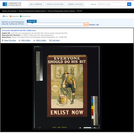
Poster showing a young man in uniform, posed with a drum, before a wall displaying enlistment posters by the Parliamentary Recruiting Committee. Some of the posters are recognizable as items in the Library of Congress World War I poster collection. Poster no. 121. Title from item.

Students learn that economic forces have an impact beyond the financial world. First, they learn that Progressive Era public health reforms inspired a commercial response to the growing demand for sanitation through the rapid increase in bathroom-fixture production. Students then use FRED, economic data from Federal Reserve Bank of St. Louis, to analyze how bathroom-fixture production changed throughout the 1920s. They examine primary documents—1920s advertising—to see how companies fused the Progressive Era with the new consumer culture. Finally, students complete the lesson by responding to AP U.S. History-style short-answer questions.
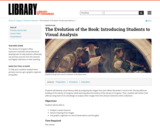
Students use Library of Congress primary sources to examine the images from John White Alexander's mural in the Thomas Jefferson building.
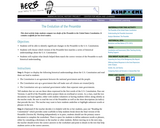
This short activity helps students compare two drafts of the Preamble to the United States Constitution. It contains scaffolds for low-level readers.

The student will use the poetry of Phillis Wheatley, Jacqueline Woodson, Countee Cullen, and Amanda Gorman to draw conclusions about the historic eras in which they wrote.

Primary sources provide firsthand evidence and perspectives of historical events by the person writing them. Students will read various types of correspondence (letters, diaries, and postcards) and analyze their content. Students will then take on the role of a citizen and write a letter as if they were part of a major event of the Civil War.
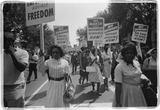
The Civil Rights Movement in America featured many different leaders, some with very different approaches they thought would help African Americans achieve equality. Of these figures Martin Luther King Jr. and Malcom X are two of the most influential. Students will analyze one writing from each of these leaders to determine what their beliefs were and how they were different from one another, before discussing these beliefs and differences with a partner. Image: Warren K. Leffler (photographer), Library of Congress (source). Public Domain.
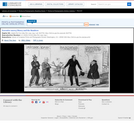
An attack on New York governor William L. Marcy's controversial decision to surrender Irish fugitives John Bamber, Sr., and his son James to the British consul after their detention in New York. The Bambers, wanted by the British government in connection with the killing of an Irish police constable, had sought asylum in the United States. Marcy's decision to return them to British custody caused a furor among New York Whigs and Irish immigrants. In the title the "A" in Marcy's name is crossed out and replaced with an "E." Marcy is shown leading the two Bambers by a rope tied to their necks toward a stout British consul on the right. The prisoners are in hand and leg irons. In the background a ship sits offshore and a heavyset man with spectacles, city recorder Richard Riker, runs up waving a writ of habeas corpus and crying "Stop! Stop!" On the left is the Hall of Justice; on the right the consul's office. Marcy's trousers are mended with a "50 cents" patch, a joke regarding a tailor's voucher for fifty cents that he submitted during his governorship of New York. Marcy: "Here my dear Sir are these savage Irishmen, whom I gladly deliver over to you, to be dealt with as the Queen's most excellent Majesty may think fit." British consul: "I thank your Excellency for your promptness, and shall represent your conduct in such a light to her most gracious Majesty, that I have not a bit of doubt she will reward you with a pair of new breeches!!" The younger Bamber: "Is this the boasted liberty of the soil? Is this the law for an adopted citizen?" Bamber, Sr.: "Is this the justice of the self-styled People's Party?"|Entered . . . 1838 by H.R. Robinson.|Printed & publd by H.R. Robinson, 52 Cortlandt St & 11-1/2 Wall St. N.Y.|Signed with monogram: C (Edward Williams Clay).|The print was registered for copyright on October 8, 1838.|Title appears as it is written on the item.|Weitenkampf, p. 55.|Forms part of: American cartoon print filing series (Library of Congress)|Published in: American political prints, 1766-1876 / Bernard F. Reilly. Boston : G.K. Hall, 1991, entry 1838-5.
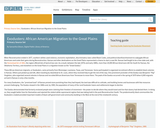
When Reconstruction ended in 1877, southern whites used violence, economic exploitation, discriminatory laws called Black Codes, and political disenfranchisement to subjugate African Americans and undo their gains during Reconstruction. Kansas and other destinations on the Great Plains represented a chance to start a new life. Kansas had fought to be a free state and, with the Homestead Act of 1862, the region offered lots of land at low cost. As a result, between the late 1870s and early 1880s, more than 20,000 African Americans left the South for Kansas, the Oklahoma Territory, and elsewhere on the Great Plains in a migration known as the “Great Exodus.”

In this lesson students will examine three documents about the Montgomery Bus Boycott (1955-1956) to determine the importance of local activists, especially women, in the civil rights movement. This lesson might serve as an introduction to a unit on the civil rights movement.

A ludicrous contrast of two influential Democrats, the obese Alabama Representative Dixon Hall Lewis and gaunt "Globe" editor Francis Preston Blair. The artist comments upon the unlikely alliance established in early 1840 between the Van Buren administration and certain Southern legislators in the circle of John Calhoun. Insinuation of Blair's corruption is also made. Lewis sits on a bench, holding his hat and walking stick before him. Blair embraces him with claw-like hands, saying, "I think Buchanan [i.e., Democratic senator from Pennsylvania James Buchanan] is making forcible illustrations of the bad effects of an inflated currency. Eh! my fat 'all y'?" Lewis responds, "Why I think, my "galvanized" friend that "you" & "I" illustrate best contraction and expansion! but d--n it Frank, it's strange you can't get fatter upon your Congressional corncrib & Treasury pap?" Blair was once called "a galvanized corpse" by South Carolina Congressman Francis W. Pickens. Two "Globe Reporters" in a gallery on the right remark, "I say Tom there is a hint in the way of geography--showing the comparative size of "Alabama" & the Globe." and "Yes! I think L--s appears quite resigned to the pressure of our lean governor's "specie claws!" "Expansion & Contraction" appears to be by the same hand as "Locofoco and Nulification Nuptials" (no. 1840-46).|Printed & published by H.R. Robinson, no. 52 Cortlandt St. N.Y. & Pennsa. Avenue Washington D.C.|Probably drawn by J. McGouldrick.|Title appears as it is written on the item.|Weitenkampf, p. 61.|Forms part of: American cartoon print filing series (Library of Congress)|Published in: American political prints, 1766-1876 / Bernard F. Reilly. Boston : G.K. Hall, 1991, entry 1840-47.

The four major wars in which American women served after World War II can be split into two pairs. Korea and Vietnam were conflicts fought in Asian countries divided by the politics of the Cold War. The Persian Gulf War and the conflicts in Afghanistan and Iraq were fought in the Middle East and grew out of tensions over aggression in that region and, in the latter instance, the 9/11 attacks. For women, the first two wars signaled few advances in their roles in military service, but in the two recent wars, the areas of women’s participation expanded immensely, with potentially more dire consequences.
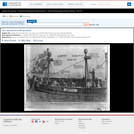
An anti-Jackson satire, critical of the President's federal treasury policy and of Vice-President Van Buren's influence on the administration's fiscal program. The print specifically attacks Jackson's plan to discontinue federal deposits in the Bank of the United States, and his "experiment" of placing them in selected state banks instead. The artist employs the image of a ship, a contemporary symbol of commerce, to forecast the ruination of American trade as a result of these measures. Jackson stands on a platform near the stern of the ship "Experiment," wielding a whip over eight crewmen who sit at spinning wheels. The ship is moored and upturned barrels sit on top of each of its three masts. A broom is tied to the foremost one, indicating that it is for sale. Rats scurry about the deck. Martin Van Buren stands behind Jackson near a padlocked door to the hold marked "Deposits" and "No Bank." A second ship burns in the distance. The various sailors comment: "Shiver my timbers Bob, if we ain't overrun with these blasted "Rats --" they eat up all our rations! I wish old Veto there, would drive 'em all overboard with little Martin at the head of them." "I say Jack I'm damn'd if this is like getting fifteen dollars a month is it?" "No, No, Shipmate, curse these spinning Jennies, its work only fit for lubbers and old women." "There is the old Constitution burning up! Her owners having no further occasion for her and cant afford to keep her in repair!" "Well what's the use of a Ship war? She's meant to protect "Commerce," but we've got none to protect!" Jackson: "No grumbling you lazy dogs! Perish commerce! perish trade! Andrew Jackson knows what's best for the Country, By the Eternal, Don't I Martin?" Van Buren: "To be sure you do if you mind what I tell you - Don't give up the ship General or I shall not succeed you!"|New York. Published by Anthony Imbert No 104 Broadway. |Title appears as it is written on the item.|Weitenkampf, p. 30.|Forms part of: American cartoon print filing series (Library of Congress)|Published in: American political prints, 1766-1876 / Bernard F. Reilly. Boston : G.K. Hall, 1991, entry 1833-8.